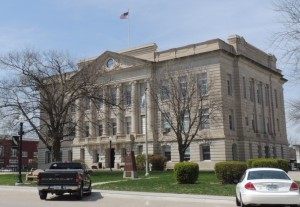 Greene County boards of supervisors have talked about updating the heating system at the courthouse several times in the last two decades but never saw a clear path to completing such a project until Monday.
Greene County boards of supervisors have talked about updating the heating system at the courthouse several times in the last two decades but never saw a clear path to completing such a project until Monday.
The supervisors agreed by consensus to move forward with replacing the 100-year-old steam boiler and radiators, installing central air conditioning, and replacing all the windows at the courthouse. The estimated cost of the entire project in early 2015 was $1.4 million. The supervisors were told they can expect the cost now to be 6-8 percent more.
Matt Cole and Holly Elbert of BBS Architects (formerly known as Brooks Borg Skiles) were at the meeting at the request of the supervisors to talk about the project. They referred to a report prepared by the firm in January 2015 that listed recommendations for the project.
Three years ago, the supervisors gave the proposal due consideration and they ultimately decided to hold off on the project until they had set aside some of the funds needed.
The county now has $400,000 set aside to begin the project.
The 2015 report suggested adding new high efficiency hot water boilers in the basement next to the original boiler and putting a chiller for air conditioning outside. Fan coil units would be placed along the windows where the radiators are now, and hanging units would be put in interior spaces. An air handler would be put in the basement for ventilation, with duct work to the four stories of the building.
Once the boilers and chiller are installed and hot water and chilled water pipes are looped around the basement, the pipes to move the hot or cold air upwards will be placed That could be done in one quadrant of the courthouse at a time.
Board chair John Muir’s first question was how the chiller, close to the size of a semi trailer, would impact the “dignity of the courthouse.” Cole assured him BBS would be “sensitive and creative” in planning where to place the chiller and how to screen it.
Of the total project cost, $1 million is HVAC and $400,000 is windows. Replacing windows would be the last phase of the project. The 2015 report calls for “historically correct” wood fixed windows similar to the 1917 windows.
“After 20 or 30 years everybody thinks it’s time for us to move forward rather than worry about it all the time,” Muir said. “What steps do we take? Where do we go next?” he asked. No motion was made to that effect, but the board members were all in agreement.
Cole and Elbert of BBS will come up with a definite plan for phasing the planning and construction of the HVAC system. Cole said he could return in two weeks with a proposal for the firm’s services to prepare design documents needed to bid out the project.
“We’re ready for that,” Muir said. “That would be great,” supervisor Mick Burkett added.
After the meeting Cole and Elbert toured the courthouse with county engineer Wade Weiss. Neither had been in the building previously.
